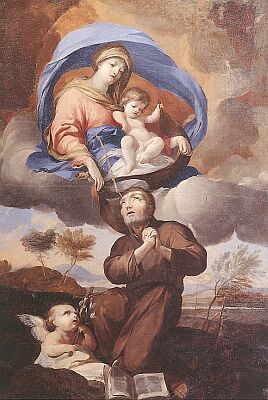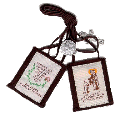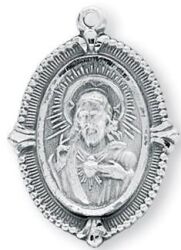Scapulars

|
A scapular is a sacramental that looks like two small pieces of wool cloth connected by string that is worn over the neck, either under or over one's clothing (typically under the clothing), such that one piece of cloth hangs over the chest, and the second piece of cloth hangs over the back (see picture below). They derive from the scapulars which make up part of monastics' religious habits -- that ankle-length (front and back), shoulder-wide, apron-like part of the habit that basically consists of a long rectangular piece of material with a hole for the head (some of them have hoods and some had ties under the arms). Monastic scapulars came, over time, to be called jugum Christi (the yoke of Christ), and receiving the scapular (becoming "invested") took on solemn meaning. Abbreviated forms of the full monastic scapulars were to be worn even at night. In addition to regular monastics of the First Order (i.e., friars) and Second Order (cloistered nuns), laity attached themselves to various religious orders, too, in what are called "Third Orders." Some  lay members of Third orders -- "tertiaries" -- are "Third Order Religious" who live in a monastic community and generally take vows; most others are "Third Order Secular" who live in the world and generally make solemn promises. In the beginning, many of these lay people were invested with the full habit; later, they came to wear only the very small scapulars, as seen at left, under their clothing. lay members of Third orders -- "tertiaries" -- are "Third Order Religious" who live in a monastic community and generally take vows; most others are "Third Order Secular" who live in the world and generally make solemn promises. In the beginning, many of these lay people were invested with the full habit; later, they came to wear only the very small scapulars, as seen at left, under their clothing. In addition to these Third Orders, Confraternities of lay-people (married or single -- just "regular Catholics") developed whose members were invested with Scapulars of Religious Orders to which they were attached. It is these scapulars for lay people belonging to a Confraternity or a Third Order that one generally thinks of when one hears the word "scapular." Some scapulars have privileges and indulgences attached to wearing them, but like any sacramental (holy water, blessed candles, etc.), scapulars are not magic; their efficacy depends on the proper intentions and faith of the wearer. Only by following through on the promises one makes when becoming invested can the benefits associated with them be had. They are best thought of as signs of a commitment to do certain things and of one's being a part of a religious community. They act as reminders, too, of these things they signify and of the Saints who are parts of the religious community in question. They are reminders to behave with holiness.
|
|
Brown Scapular "The Brown Scapular of our Lady of Mount Carmel," associated with the Carmelite Order, is the most well-known. In A.D. 16 July 1251, Our Lady appeared to St. Simon Stock in Cambridge, England after he prayed for help for his Order. She appeared to him with the scapular and said, "Take, beloved son this scapular of thy order as a badge of my confraternity and for thee and all Carmelites a special sign of grace; whoever dies in this garment, will not suffer everlasting fire. It is the sign of salvation, a safeguard in dangers, a pledge of peace and of the covenant."
You can be enrolled in the Confraternity of our Lady of Mount Carmel by any priest. Just obtain a scapular, take it to him to have it blessed, and express your desire for enrollment. Rev. Mother Superior |
|
Blue Scapular "The Blue Scapular of the Immaculate Conception" originated with the foundress of the Theatine Order of nuns, Venerable Ursula Benicasa. To her, Christ promised favor to that Order and she asked Him to extend those promises to those who associated themselves with the Order through the faithful wearing of the Scapular. The Blue Scapular is worn for the conversion of sinners. |
|
Red Scapular "The Red Scapular of the Passion" came about when a Sister of Charity of St. Vincent de Paul had a vision of Christ in 1846 in which He promised an increase in the theological virtues (Faith, Hope, and Charity) of those who wore the scapular faithfully and contemplated His Passion. One side of the scapular shows Christ on the Cross, with the words, ""Holy Passion of Our Lord Jesus Christ Save us"; the other side shows the Sacred Heart of Jesus and the Immaculate Heart of His mother with the words, "Sacred Hearts of Jesus and Mary, protect us." |
|
Black Scapular "The Black Scapular of the Seven Dolors of Mary," or "The Our Lady of Sorrows Scapular," has on its front a depiction of Our Lady of Sorrows. Our Lady appeared to seven rich and prominent citizens of Florence who decided to give up their worldly possessions and follow Christ, promising to honor His Mother in her sorrows. Thus began the Servite Order. Mary gave them the Servite habit and said that "these garments shall be to you a perpetual memory of the sufferings of my heart." This is the more common Black Scapular. |
|
Black Scapular St. Paul of the Cross, before founding the Congregation of the Passionists, received in apparitions the black habit of the order with the badge on the breast. Later, after the foundation of the congregation, the Passionist Fathers gave the faithful who wished to associate themselves more closely with their order a black scapular in honour of the Passion of Christ. "The Black Scapular of the Passion" has a replica of the emblem worn on the habits of the Passionists. It includes the words "Jesu XPI Passio" and below "sit semper in cordibus nostris." |
|
White Scapular "The Scapular of the Most Blessed Trinity" is the badge of the members of the Confraternity of The Most Blessed Trinity. Its front depicts a red and blue Cross, and it first came about in 1198 when a Spanish priest, John of Matha, had a vision of an angel wearing a white robe adorned with a Cross whose vertical line was red and whose cross-beam was blue (this Cross design came to be on the habit of the Trinitarian Order). This Scapular was first used for the purposes of of increasing action to "ransom the captives" -- the Christians taken prisoner by Muslims. |
|
Green Scapular In 1840, Mary appeared to Sister Justine Bisqueyburu (a Seminary Sister of the Daughters of Charity) in Paris, France and commended the Green Scapular to her. It's known as "the Scapular of Conversion," and its promises are the strengthening of faith, protection against Satan, a happy death for Catholics, and, most of all, for conversion for those outside the Church. It's to be worn or carried by the faithful, or given to an unbeliever for their conversion. The following prayer is to be said daily by the wearer: Immaculate Heart of Mary, pray for us now and at the hour of our death If the scapular is given to an unbeliever for their conversion, the person giving the scapular prays the prayer for them if the unbeliever does not want to pray the prayer himself. If the unbeliever does not want the scapular, it may be hidden in their vicinity and the prayers said for him. Enrollment in a Confraternity is not necessary for this scapular, but the scapular should be blessed by a priest before use. |
|
Scapular of St. Joseph A gold and violet-colored scapular with a white cord, the front shows St. Joseph holding the child Jesus in one arm and a staff of lillies on the other. Underneath are the words, "St. Joseph, patron of the Church, pray for us." On the back of the scapular are the papal crown under a dove as the symbol of the Holy Ghost. Underneath those are the Cross, the keys of Peter, and the inscription: "Spiritus Domini ductor eius" (The Spirit of the Lord is his Guide). |
|
The Five-Fold Scapular is made of 5 of the following Scapulars above: first, the "The Red Scapular of the Passion," then the "The Scapular of the Most Blessed Trinity," the "The Brown Scapular of our Lady of Mount Carmel," the "The Black Scapular of the Seven Dolors of Mary," and the The Blue Scapular of the Immaculate Conception." Any priest can invest you with this scapular.
Holy Office December 16, 1910 |
